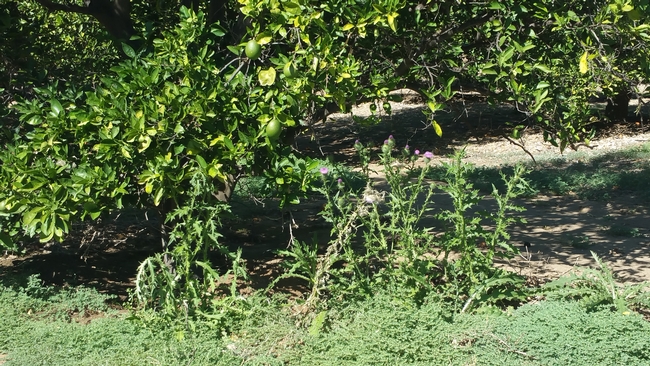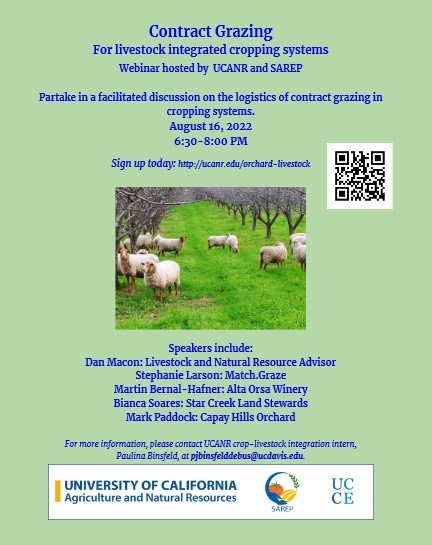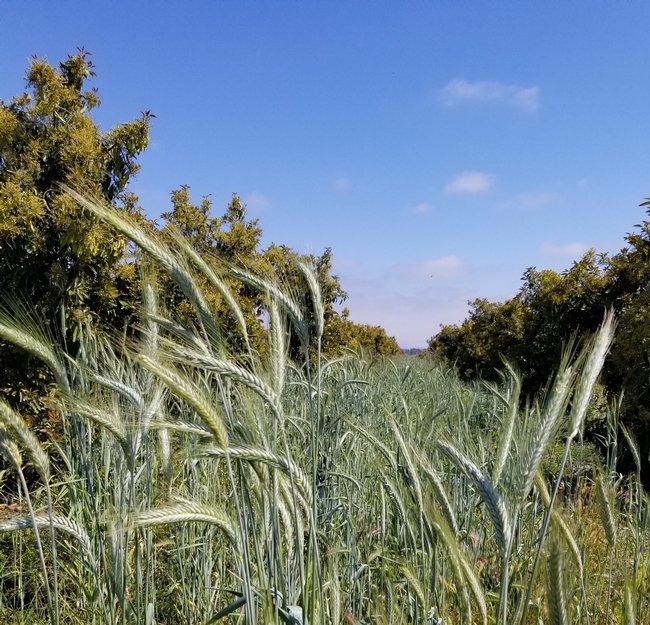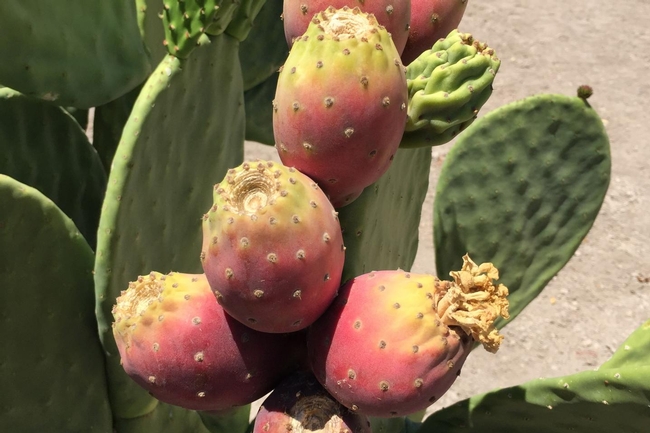
Posts Tagged: crops
Tree Crop Herbicides
Control of weeds has always been a major economic cost in subtropical fruit production because of favorable climate that allows for weed germination and year-round growth. The use of chemical weed control has increased dramatically due to labor costs, equipment costs, product costs and availability, the shift to more narrowly spaced tree rows, and installation of low volume irrigation systems that prohibit the operation of mowing or tillage equipment under the tree canopy area (Futch 2001).
However finding herbicides that are labeled for certain subtropical crops can be a bigger challenge. UC Weed Science has updated the Subtropical Crops herbicides usage chart for California growers (2020). It also seems that preventive programs are most frequently overlooked as a method of weed control. Preventive programs entail the use of such practices as sanitation, spot spraying, or hand labor to prevent the source of weed infestation (seed and/or vegetative) from widespread dissemination throughout a given area. By removing the undesirable weed species prior to seed development, dissemination by wind or mechanical transport on equipment can be effectively delayed.
Weed control programs will vary from location to location within the state and can even vary within a given site based upon specific conditions such as soil type, variety, method of herbicide application, and the presence of specific weed species.
Before herbicide application, growers should survey the grove and determine the stage of growth and type of weeds for that given location. Many products do not provide control of emerged species, thus requiring the application of more than one product to provide both preemergence and postemergence protection. Rotation of soil-applied herbicides should also be considered to prevent the buildup of resistant annual and perennial weeds. The resistant species may not be evident initially; however, if the same herbicide and cultural program is maintained, over time their populations may build up until they infest the entire grove and become the dominant weed species.
Herbicide damage to foliage and fruit has also been noted when herbicides were applied under windy conditions or use of improper equipment allowed the materials to contact areas other than the weeds or soil. Please make sure to follow the label's direction and use caution.
Attached is a chart listing herbicides registered for avocado, citrus, date, kiwi, fig and pomegranate, along with the Big Trees' herbicides. Check out how many more are available on almond than avocado. Both start with an A.
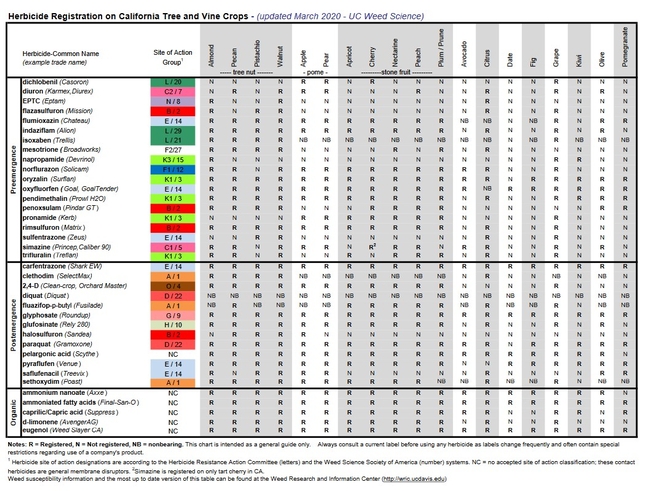
herbicides on trees 2020
Sheep Grazing in Vineyards and Fields

Vineyard grazing flyer (002)
Cowpeas Can Make Money in Spanish Mandarins
If you can sell your cowpeas, fava beans and barley, you can make money in Spain and apparently not use any more water than if just growing the mandarins. And coastal growers should look at the fresh market. Have you ever tasted a fresh green cowpea or fava bean? Pretty darn good and consumers think so, as well.
A Diverfarming project study compares the environmental footprint and the economic performance of traditional mandarin monocropping as opposed to growing mandarin intercropped with herbaceous crops and the use of deficit irrigation
The transformation towards intensive agriculture has led to agricultural practices in Europe that have centred on increasing the yield and reducing costs in recent decades, and which involve a major dependence on external sources of agrochemicals and energy. These intensive monocropping systems have generated biodiversity losses, water contamination, and high rates of greenhouse gas emissions, as well as degrading the soil and reducing the ecosystem services.
Faced with this situation, the European Diverfarming project has trialled the diversification of crops throughout the European Union, seeking the best practices to combine crops and focusing on reducing inputs to find the best options to preserve the sustainability of the systems and increase the resilience of the European agricultural sector. To do so, it is also necessary to know the impacts of these practices both at environmental as well as economic level.
With the aim of knowing the environmental footprint and the economic performance of the introduction of herbaceous crops among the alleys of the mandarin trees using controlled deficit irrigation in a mandarin grove located in the Region of Murcia, a team of researchers from the Universidad Politécnica de Cartagena have carried out a life-cycle assessment of the crop and an evaluation of the costs and income of the farm for the three years that the experiment in this case study was carried out.
Although the growing area increased with the introduction of the herbaceous crops (in this case purslane, cowpea, broad beans, and a barley-vetch mix), no detrimental effects occurred in terms of exhausting resources, acidification, or global warming. Therefore, the practice of intercropping did not cause additional contamination or other environmental impacts. This, in addition to the results of the increase in nitrogen and organic carbon content and in the soil and the reduction in erosion and run-off makes the introduction of herbaceous crops in the alleys of the mandarin trees a good sustainable environmental option to cope with the current challenges of the sector.
In economic terms, the financial security of the agricultural community also becomes a key element for successfully adopting diversified systems. This study highlights, through the economic assessment, that intercropping can lead to an increase in production costs, mostly related with a greater demand for labour in comparison with monocropping. However, the study also concludes that “the correct choice of intercropping practices can bring economic advantages”. The results showed that the mandarin crop with purslane and broad beans as intercrops could be profitable and reduce the risk for the grower against volatile prices in the main crop.
In this way, considering all the potential environmental and economic benefits of intercropping practices, these systems arise as a tool to move towards more sustainable and profitable agricultural systems. The valorisation of agricultural products that are more respectful to the environment on the part of consumers and the backing of public funding (e.g., direct help to growers who introduce intercropping) are key aspects to drive the adoption of these practices.

pixie harvest 2
Avocados and Cover Crops
Alli Rowe-Fish and Ben Faber
Cover crops offer an important opportunity to build soil health in avocado orchards. A cover crop is a crop seeded or encouraged as natural plant cover as an investment in soil fertility and not as a cash crop. Most cover crops are grasses, legumes, brassicas or a mixture and serve to protect bare soil while improving soil physical, chemical, and biological properties.
Benefits of cover crops
Perennial systems, trees in the ground for long periods of time, are unable to harness the benefits of crop rotation that include improved nutrient cycling, soil tilth, soil physical properties, weed and pest suppression, and erosion control. By cycling cover crops, growers of tree crops can mimic crop rotation on a portion of the land surface and maximize benefits in an orchard system.
The benefits of cover crops in California avocado orchards include:
- Improved soil structure;
- Reduced soil compaction;
- Reduced soil erosion from wind and rain;
- Increased soil organic matter content;
- Improved nutrient cycling;
- Weed suppression;
- Creation of habitat for pollinators and beneficial insects;
- Improved water infiltration
- Improved soil moisture storage
- Increased soil aeration
- Disease suppression.
California will continue to experience increased intensity and duration of drought and heat stress days. These environmental conditions dramatically impact fruit set and viable production of avocados. Improving soil health builds resiliency to climatic conditions and allows farmers to continue to grow in the face of climate change. A specific consideration is improved water infiltration achieved by cover cropping in orchards. The enhancement in soil structure due to the presence of varying depths of roots allows for precipitation to infiltrate rather than run off. By keeping precious precipitation on the orchard property, growers become more resilient in the face of drought and heat. Improved infiltration by rain water can improve salt leaching and reduce salt stress on the tree.
Selecting a cover crop
The main consideration in selecting a cover crop is to identify the purpose and objectives for its use. Table 1 identifies specific goals and considerations for cover cropping. Most avocado growers in California will opt for a winter cover crop to harness winter rains to avoid irrigating. Therefore, the following selections are geared towards winter cover crops and do not go into detail for summer cover cropping.
Cover crop mixes may be more expensive than single species covers such as only a brome or a medic, but satisfy multiple purposes in one planting and often see successful establishment and growth rates. They may provide better cover, weed suppression, and biomass, especially during drought or other non-optimal growing conditions. In addition, mixes supply multiple nutrients and benefits beyond a single species. For example, a mix that includes triticale, faba bean, and daikon radish sees the benefit of soil stabilization and infiltration from all three species, increased carbon content from the triticale, nitrogen fixation from the faba bean, and reduced soil compaction from the radish.
In selecting a cover crop, it is critical to consider any pests that may be encouraged with certain species. For example, many avocado growers are constantly battling gophers in young orchards. Gophers love clover varieties, so if you already have more gophers than you can handle, consider choosing a cover crop mix that does not contain clovers. There does not appear to be an increase of ground squirrel activity with covers (https://digitalcommons.unl.edu/cgi/viewcontent.cgi?article=1020&context=vpc17).
Table 1. Cover Crop Categories and Considerations
Seeding timing
The timing of cover crop seeding will vary based on location and operational goals. However, flexibility is key for getting cover crops seeded at the right time to maximize winter rainfall for good establishment. Many cover crop seed companies will recommend seeding in fall, October or November. In Central and Southern California, that time frame tends to be hot, dry, and windy – not ideal conditions to seed a cover crop. The best time to seed would be right after the first rains come to loosen the soil and provide a bit of moisture. The key to success lies in watching the weather and being able to jump on a window between early rain events.
Frost can be a consideration for many avocado growers in Central and Southern California. Early establishment of tall cover crops can increase risk of frost exposure and should be avoided. To get around frost issues, seeding later in the fall and early winter can delay growth of the cover crop until the frost prone days have passed. This may mean seeding in early January to ensure minimal growth during January and February when frost may be a concern. As the weather warms in March, cover crops can take off and build biomass without posing a risk to tree health.
Termination strategies
Winter cover crops are generally terminated nearing the last rainfall events so they do not compete with trees for irrigation water. Termination strategies vary based on type of cover crop and availability of equipment. Cover crops can be terminated by mowing, tillage/disking, grazing, or simply allowing them to dry up if they are low growing. Leaving cover crop residue on the surface protects the soil from wind erosion, acts as a natural mulch to suppress weed seedlings, and releases nutrients to the soil as it decomposes. The downside to leaving residue on the surface is the retention of moisture which could provide habitat for slugs and snails. Incorporating cover crop residue immediately after termination speeds up the decomposition time, increasing nutrient release into the soil. This should only be considered in young or=chards where root damage would not occur due to incorporation. This, however, requires the right equipment and relatively flat terrain, which is not representative of most California avocado operations. Grazing is an effective termination strategy to remove high biomass cover crops. However, it is important to consider GAP and NOP food safety regulations by ensuring animals are not in the orchard within 90 days of harvest.
Triticale and Lamb Hass
With Climate Change Will We Grow Cactus?
medias contact: whartonc@unr.edu
Could cactus pear become a major crop like soybeans and corn in the near future, and help provide a biofuel source, as well as a sustainable food and forage crop? According to a recently published study, researchers from the University of Nevada, Reno believe the plant, with its high heat tolerance and low water use, may be able to provide fuel and food in places that previously haven't been able to grow much in the way of sustainable crops.
Global climate change models predict that long-term drought events will increase in duration and intensity, resulting in both higher temperatures and lower levels of available water. Many crops, such as rice, corn and soybeans, have an upper temperature limit, and other traditional crops, such as alfalfa, require more water than what might be available in the future.
"Dry areas are going to get dryer because of climate change," Biochemistry & Molecular Biology Professor John Cushman, with the University's College of Agriculture, Biotechnology & Natural Resources, said. "Ultimately, we're going to see more and more of these drought issues affecting crops such as corn and soybeans in the future."
Fueling renewable energy
As part of the College's Experiment Station unit, Cushman and his team recently published the results of a five-year study on the use of spineless cactus pear as a high-temperature, low-water commercial crop. The study, funded by the Experiment Station and the U.S. Department of Agriculture's National Institute of Food and Agriculture, was the first long-term field trial of Opuntia species in the U.S. as a scalable bioenergy feedstock to replace fossil fuel.
Results of the study, which took place at the Experiment Station's Southern Nevada Field Lab in Logandale, Nevada, showed that Opuntia ficus-indica had the highest fruit production while using up to 80% less water than some traditional crops. Co-authors included Carol Bishop, with the College's Extension unit, postdoctoral research scholar Dhurba Neupane, and graduate students Nicholas Alexander Niechayev and Jesse Mayer.
"Maize and sugar cane are the major bioenergy crops right now, but use three to six times more water than cactus pear," Cushman said. "This study showed that cactus pear productivity is on par with these important bioenergy crops, but use a fraction of the water and have a higher heat tolerance, which makes them a much more climate-resilient crop."
Cactus pear works well as a bioenergy crop because it is a versatile perennial crop. When it's not being harvested for biofuel, then it works as a land-based carbon sink, removing carbon dioxide from the atmosphere and storing it in a sustainable manner.
"Approximately 42% of land area around the world is classified as semi-arid or arid," Cushman said. "There is enormous potential for planting cactus trees for carbon sequestration. We can start growing cactus pear crops in abandoned areas that are marginal and may not be suitable for other crops, thereby expanding the area being used for bioenergy production."
Fueling people and animals
The crop can also be used for human consumption and livestock feed. Cactus pear is already used in many semi-arid areas around the world for food and forage due to its low-water needs compared with more traditional crops. The fruit can be used for jams and jellies due to its high sugar content, and the pads are eaten both fresh and as a canned vegetable. Because the plant's pads are made of 90% water, the crop works great for livestock feed as well.
"That's the benefit of this perennial crop," Cushman explained. "You've harvested the fruit and the pads for food, then you have this large amount of biomass sitting on the land that is sequestering carbon and can be used for biofuel production."
Cushman also hopes to use cactus pear genes to improve the water-use efficiency of other crops. One of the ways cactus pear retains water is by closing its pores during the heat of day to prevent evaporation and opening them at night to breathe. Cushman wants to take the cactus pear genes that allow it to do this, and add them to the genetic makeup of other plants to increase their drought tolerance.
Bishop, Extension educator for Northeast Clark County, and her team, which includes Moapa Valley High School students, continue to help maintain and harvest the more than 250 cactus pear plants still grown at the field lab in Logandale. In addition, during the study, the students gained valuable experience helping to spread awareness about the project, its goals, and the plant's potential benefits and uses. They produced videos, papers, brochures and recipes; gave tours of the field lab; and held classes, including harvesting and cooking classes.
Fueling further research
In 2019, Cushman began a new research project with cactus pear at the U.S. Department of Agriculture - Agricultural Research Service' National Arid Land Plant Genetic Resources Unit in Parlier, California. In addition to continuing to take measurements of how much the cactus crop will produce, Cushman's team, in collaboration with Claire Heinitz, curator at the unit, is looking at which accessions, or unique samples of plant tissue or seeds with different genetic traits, provide the greatest production and optimize the crop's growing conditions.
"We want a spineless cactus pear that will grow fast and produce a lot of biomass," Cushman said.
One of the other goals of the project is to learn more about Opuntia stunting disease, which causes cactuses to grow smaller pads and fruit. The team is taking samples from the infected plants to look at the DNA and RNA to find what causes the disease and how it is transferred to other cactuses in the field. The hope is to use the information to create a diagnostic tool and treatment to detect and prevent the disease's spread and to salvage usable parts from diseased plants.
Among three cactus varieties researched by the University of Nevada, Reno as drought-tolerant crops for biofuel, Opuntia ficus-indica produced the most fruit while using up to 80% less water than some traditional crops. And spineless too.
Photo by John Cushman, University of Nevada, Reno.
https://onlinelibrary.wiley.com/doi/10.1111/gcbb.12805

